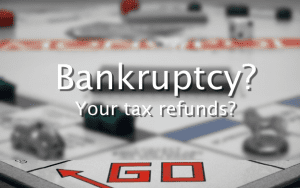we have answers.
If you’re facing bankruptcy, you may be wondering how tax refunds are treated in such a situation.
Here are some general guidelines on how the Australian Taxation Office (ATO) deals with these situations. However, you should always get professional advice for your particular situation.
When The Taxman Is Also The Creditor
If the ATO is a creditor in the bankrupt estate, it can keep any tax refunds to satisfy the tax debt owed during the bankruptcy period. However, once the bankruptcy is discharged it can no longer keep any tax refunds to satisfy the tax debt owed before the bankruptcy.
If the refund claimed by the ATO was for a post-bankruptcy tax period, the amount will also be included as income in that assessment period.
If the ATO does not claim the refund, and it relates to a pre-bankruptcy tax period, the full amount vests in the trustee.
If the refund relates to both a pre-bankruptcy and post post-bankruptcy tax period:
- a pro rate will vest in the trustee for the pre-bankruptcy
- the post-bankruptcy amount of the refund is included as income in the relevant contribution assessment period.
Example: If your estate filed for bankruptcy on 28 March 2011:
- you need to pay the pre-bankruptcy portion to the trustee. In this case, it’s 271 days (1 July 2010 to 28 March 2011) or 74.25% of the year.
- You can keep the post-bankruptcy portion, which is 94 days (29 March 2011 to 30 June 2011) or 25.75% of the year. This will treated as income during this assessment period.
If the refund relates only to a post-bankruptcy tax period, the amount of the refund is included as income in the relevant contribution assessment period.
If you’re in any doubt about where you or any of your clients stands in relation to their tax refunds during or after a period of bankruptcy, just drop us a line.



